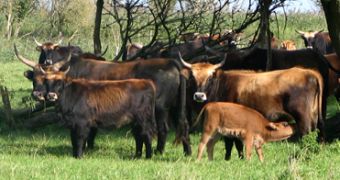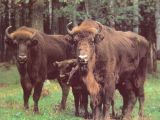Around 1500 AD, Europeans managed to kill the last ancestors of the domestic cattle, called aurochs. The auroch was a giant animal as compared to the domesticated cattle (1.8 m or 6 ft height in withers, compared to around 1.5 m or 5 ft in modern cattle).
The body was black and the horns were lyre-shaped and set in a forward angle, being much larger than in the case of the domestic cattle. With all its size, the auroch was agile and swift and lived in herds in plains, close to swamps and reed areas.
The beast was hunted for its meat and the horns were used for making cups and alpenhorns. Aurochs were robust, and often semidomesticated for being crossed with domestic cattle.
Between 1931-1938, Dr. Lutz Heck, director of Zoo Berlin, attempted to recreate the auroch starting with the domestic cattle, through cross breeding of the most primitive known cattle breeds. The result is the Heck cattle, resembling a lot the extinct auroch (Bos primigenius), but still a dwarf as compared to it, and having smaller horns.
The European bison, also called wisent (Bison bonasus), once inhabited Europe till 73o N, being present up to southern Sweden, Great Britain, Bulgaria, northern Italy, Asia Minor, Caucasus and northern Turkestan.
The European bison was hunted excessively as well and, by 1852, they disappeared from the Carpathians area, the last strongholds being in the Bialowieza Forest (Poland) and Caucasus. During the first World War, the species went extinct in the wild, but populations could be rebuilt starting with Zoo individuals, and today herds (free or in semicaptivity) are found in Poland, Lithuania, Belarus, Ukraine, Romania, Russia, Slovakia, Latvia, Kyrgyzstan and Moldova.
The wisent head is found on the emblem of the medieval kingdom of Moldavia (and also on modern Romania and Moldova).
This species is a little smaller than the American bison, but still it is 2 m (6.6 ft) tall, weighing 500-800 kg (1,100-1,800 pounds). The animal is swift and can climb rocky slopes.
Unlike the American bison, this is a forest animal (that's why it is smaller), staying close to waters and swamps. Just like a bull, the angered wisent hits the soil with the fore limb, agitating its tail and shaking its head, but if not wounded or enraged, it will avoid people. Once, the bear and the wolf were its predators. The wisent lives 30 to 40 years.
By the day the animals ruminate or bath in mud, going out for grazing in the evening. Wisents feed on grasses, leaves, mosses, twigs and bark (of ash, elm, willow and poplar).

 14 DAY TRIAL //
14 DAY TRIAL // 
